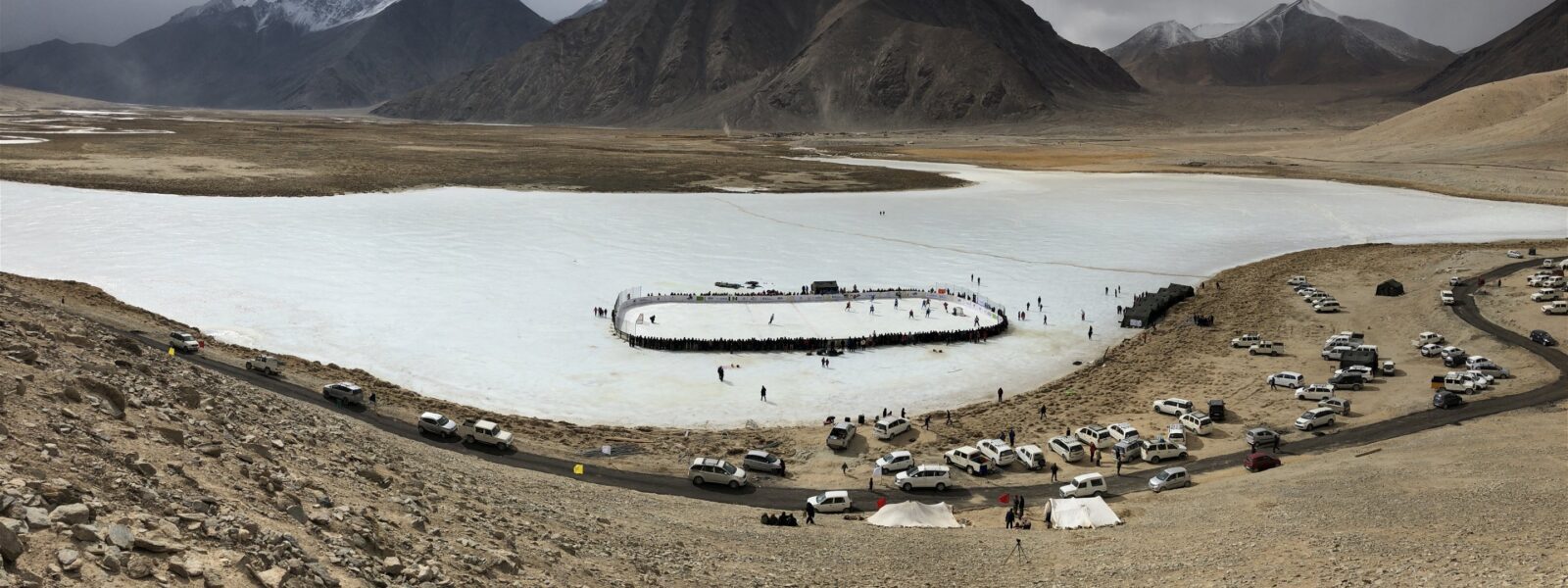Above the Silent Ice: Of Altitude, Memory, and Motion
By Elena Marlowe
1. Introduction — Where the Sky Turns to Ice
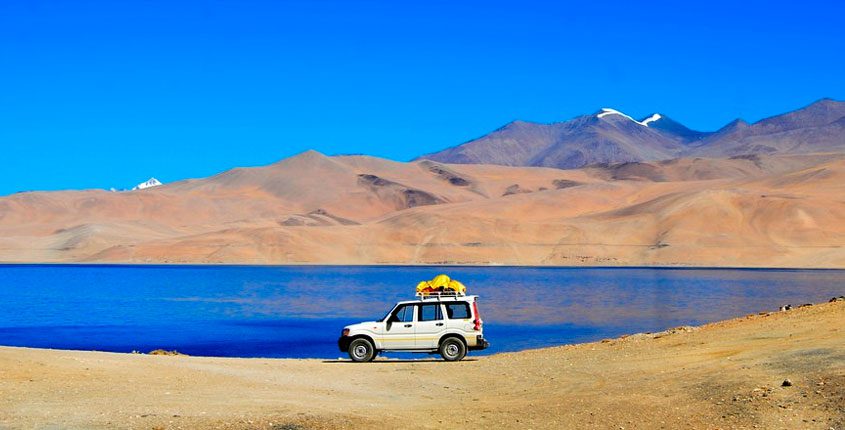
The Thin Air of Thought
When you travel beyond Leh, past the wind-worn stupas and into the vast plateau of Changthang, the world begins to rise beneath you. The air thins, not just in oxygen but in sound. The sky feels dangerously close, and each step becomes a conversation between lungs and landscape. At 4,361 meters, in a remote Ladakhi village called Chibra Kargyam, the idea of a game turns into a kind of faith. Here, ice hockey Ladakh is not merely a sport—it is the choreography of survival, the celebration of endurance, and the poetry of movement on frozen silence.
The Chibra Kargyam ice hockey ground is often cited as the world’s highest natural ice rink, a place where frozen ponds reflect prayer flags instead of stadium lights. To stand on that ice is to skate not against opponents but against gravity, against thin air, and sometimes, against the fading winter itself. It is a human attempt to write motion on a surface that vanishes with the sun.
Why Ice Hockey Found a Home Here
Ladakh’s fascination with ice hockey began as an adaptation rather than an import. Long before fiberglass sticks and plastic helmets reached this altitude, villagers would glide across frozen ponds using wooden slats and handmade pucks. Soldiers stationed near the Line of Actual Control would later bring structured matches and gear, transforming improvisation into discipline. The sport took root because it mirrored Ladakhi life itself—fast, unpredictable, and dependent on the generosity of the cold.
Today, organizations like the Ladakh Ice Hockey Association and initiatives such as iSKATE support the sport’s evolution. Yet, in Chibra Kargyam, things remain elemental. The rink is still a natural sheet of ice formed by subzero nights, its edges lined with stones and laughter. And perhaps this is what makes it more than a game: it is a communal heartbeat in a land that measures time by the melting of snow.
2. The Ascent of Silence — The Journey to Chibra Kargyam
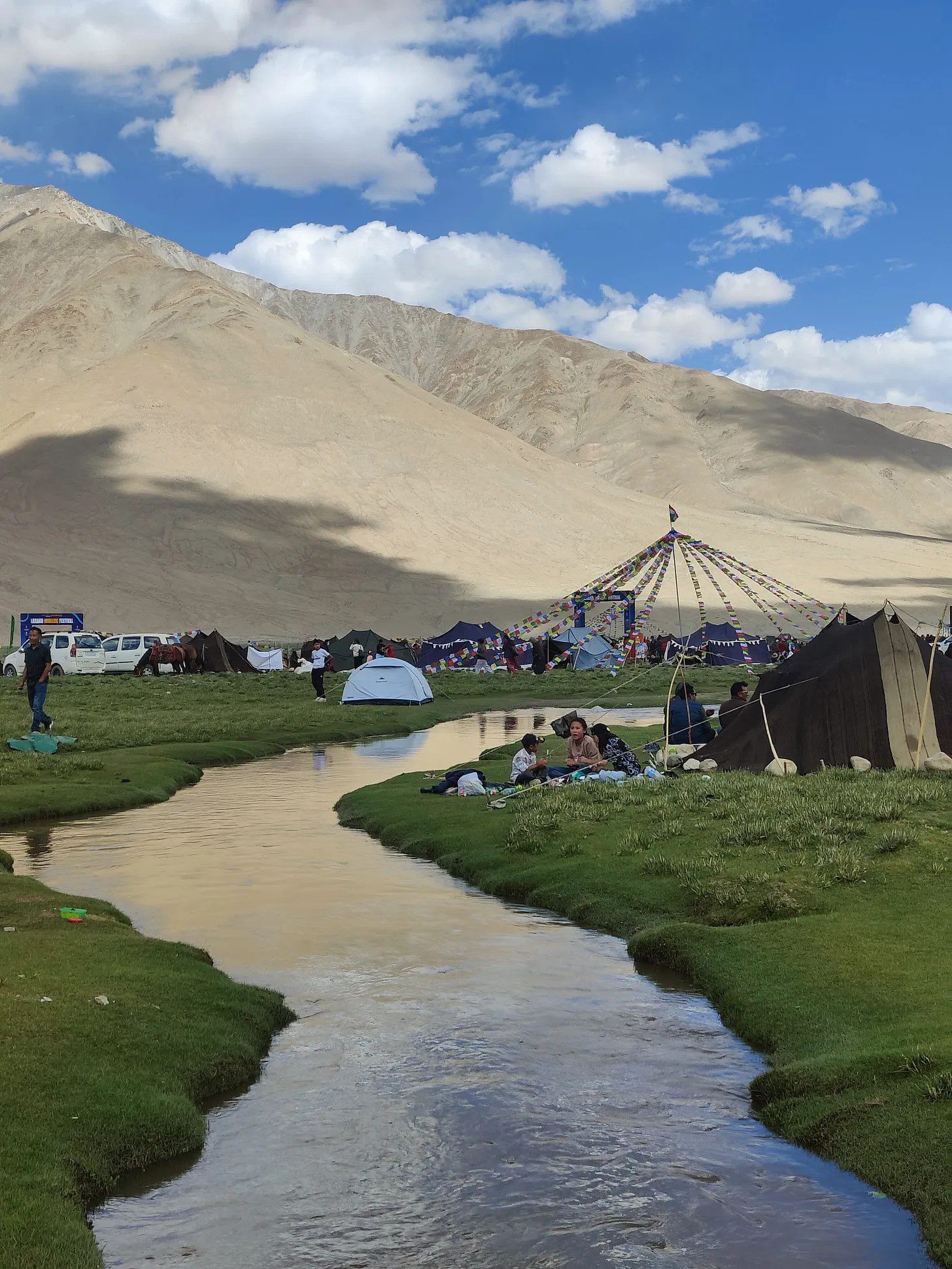
Crossing the Plateau of Breath
The road to Chibra Kargyam is not a road in the usual sense; it is a series of intentions laid across the high-altitude desert. You travel eastward from Nyoma, the wind biting even through the window glass, as wild kiangs graze against a horizon that seems to tilt. The Changthang plateau stretches endlessly, a geography of extremes where stillness carries its own sound.
In such terrain, acclimatization for high-altitude sports becomes not just practical advice but a form of meditation. One learns to breathe slower, to move with the rhythm of the land. By the time the village appears—a cluster of earthen homes and barley fields frozen under the Himalayas—the traveler has already been stripped of any illusion of control.
Here, even the children who fetch water from the frozen stream carry the mountain’s composure. They are used to the thin air, the harsh light, and the weight of sky pressing close. For them, the rink is a playground of purity—a mirror for both sunlight and dreams.
The Village Beneath the Wind
Chibra Kargyam sits between two frozen rivers, a settlement where silence is as much an element as air or stone. At dawn, the sound of a distant yak bell mixes with the metallic crack of ice. Women tend to fires that smell faintly of juniper, while men walk toward the open expanse that, come January, will become the rink.
Unlike the artificial arenas of Europe or Canada, the natural ice rink in Ladakh is ephemeral. It lives and dies with the cold. The villagers nurture it with buckets of water each night, smoothing its surface by lantern light. It is this nightly ritual—an act of faith against temperature—that turns the rink into a sacred ground.
Visitors who arrive here rarely speak loudly. Even laughter feels altered by altitude, stretched thin like the sound of wind through a prayer wheel. The village doesn’t boast about having the highest altitude ice hockey ground in the world; it simply tends it, season after season, as one tends a fragile truth.
Skating as a Way of Belonging
When the players gather—young men in mismatched jerseys, soldiers, and girls from nearby schools—the ice becomes a democracy of motion. There are no sponsors, no advertisements, only breath and coordination. Skating at this elevation demands humility. The body tires faster, mistakes multiply, and the smallest victory—a clean pass, a balanced glide—feels monumental.
As one player tells me, “Here we don’t play for trophies. We play to feel alive.” His words echo in the crystalline air, mingling with the rhythmic scrape of blades and the occasional cheer that vanishes into the mountains.
In that moment, the altitude meets attitude—a phrase I overheard from a coach in Leh—feels truer than ever. This is not sport for spectacle but for spirit. The game is a reminder that life itself, especially at such heights, is always played against odds and yet with grace.
3. Skating Against Gravity — The Ice, the Wind, the Human Pulse
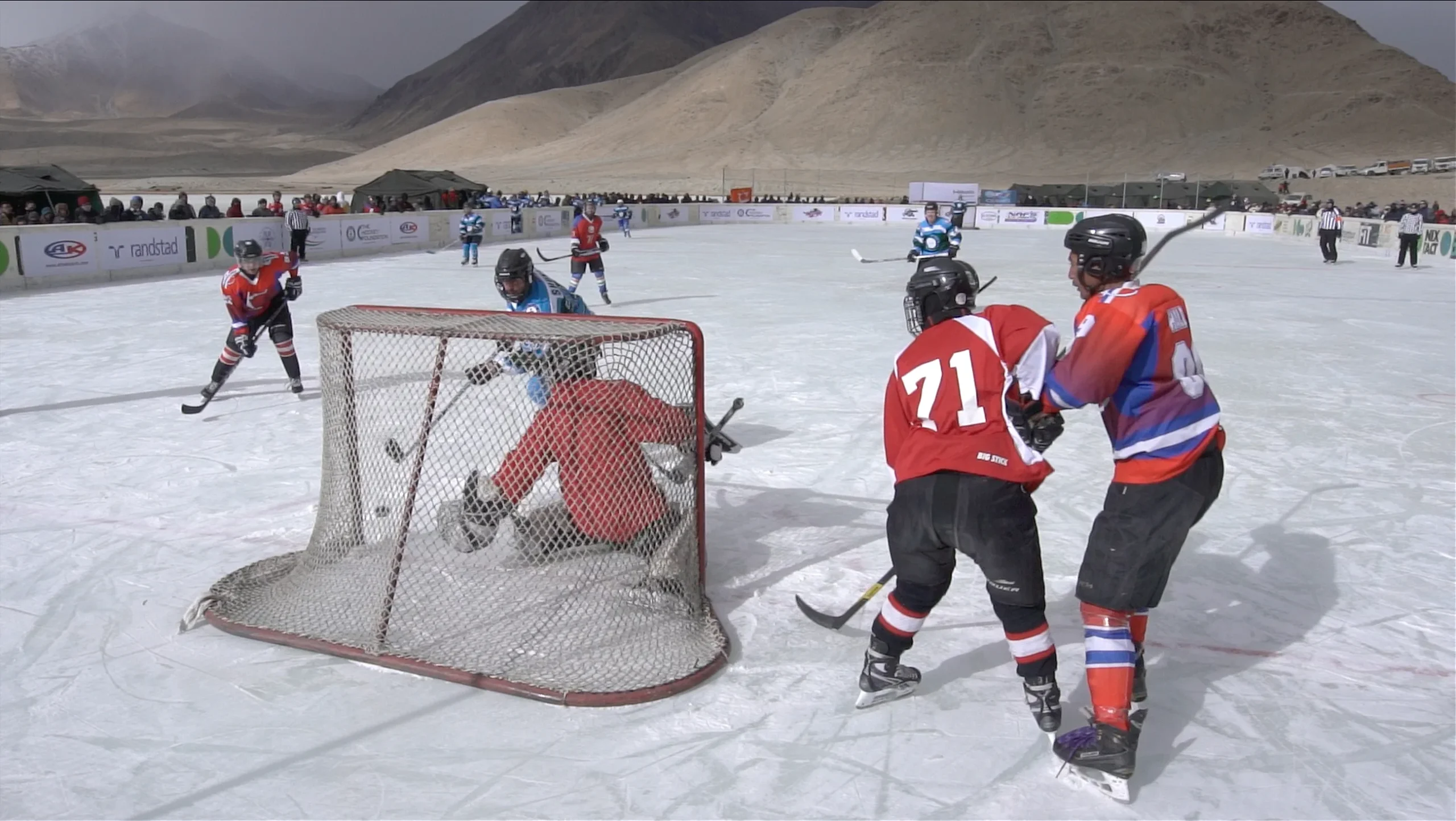
The Skin of Ice, the Light of Altitude
The ice in Chibra Kargyam has its own moods. At sunrise, it blushes faintly gold; by noon, it glitters like hammered glass. Skating upon it is like tracing light itself. The rink, surrounded by silent peaks, reflects both sky and exhaustion. For players, this is the highest elevation ice rink they will ever know—a surface both gift and challenge.
As the wind sweeps down from the Chang Chenmo range, it polishes the ice until it hums. Spectators wrap themselves in wool shawls, their breath visible as ghosts. There are no stands, no boards—just earth, ice, and the human pulse. It is here, in this open amphitheater of cold, that sport sheds its boundaries and becomes elemental.
Some matches coincide with the Ladakh Winter Sports Festival, where soldiers and civilians face each other in games that feel less like competition and more like communion. The altitude becomes the true referee—unyielding, impartial, ancient.
Altitude and the Art of Endurance
Altitude changes everything—the heartbeat, the physics of movement, even the perception of sound. Here, skating is slower, heavier, and strangely more mindful. Each stride is a meditation in friction and balance, a way to measure the limits of the human body. The players’ breath rises like steam from the ice, blending with the mist of the morning.
There are moments when the puck seems to defy gravity, moving almost lazily through the thin air. And yet, in those moments, one senses the profound beauty of fragility—how sport, art, and endurance intersect.
Even the equipment carries stories. Gloves repaired with yak leather, helmets passed down from military camps, and pucks made from melted rubber. Every mark on them is a chronicle of adaptation, a survival note written in cold script.
4. Faces on the Ice — People Who Keep It Alive
The Women Who Skate Against Expectation
In recent years, Ladakh’s women have claimed their own space on the ice. At first, they faced hesitation—questions about tradition, propriety, and necessity. But they came anyway, carrying sticks, laces, and quiet defiance. Many of them had never seen professional arenas; they learned balance from frozen ponds behind their homes.
Now, some represent India in international tournaments, their beginnings traced to places like Chibra Kargyam. Their determination is changing the cultural topography of sport in Ladakh. “When we skate, the ice does not ask if we are men or women,” one player says. “It only asks if we can stand.”
Their presence is not just participation—it is transformation. And when the sunlight breaks over the frozen ground, their silhouettes glide like calligraphy written in courage.
The Guardians of the Rink
Every winter, the villagers become engineers of impermanence. They pour water in the night cold, hammer down edges, and whisper small prayers for the ice to hold. Soldiers lend hoses from their camps, children carry buckets, and dogs bark at reflections under the moon. The rink is communal, fragile, beloved.
There are no mechanical freezers, no artificial compressors—only wind, altitude, and devotion. Maintaining the natural ice rink in Ladakh requires patience and precision, the kind usually reserved for monasteries or manuscripts. The reward is not profit, but pride—a sense that even the most remote community can create a place where the world might pause to watch.
When the Ice Begins to Melt
By late February, the first signs of thaw appear—tiny cracks like lines on a palm. The surface softens, games shorten, and laughter takes on a nostalgic edge. The villagers know this cycle well. For them, the melting ice is not an end but a continuation, a reminder that every form of joy in this region is seasonal.
Still, the changes come faster now. Climate change in Ladakh shortens winters and makes natural rinks harder to sustain. The older players speak of ice that once lasted till March. Now, they finish their matches under the watch of an impatient sun.
They skate anyway. Because in a world of uncertainty, the act of playing itself becomes resistance—an offering to memory and sky.
5. Between Movement and Stillness — The Philosophy of Ice
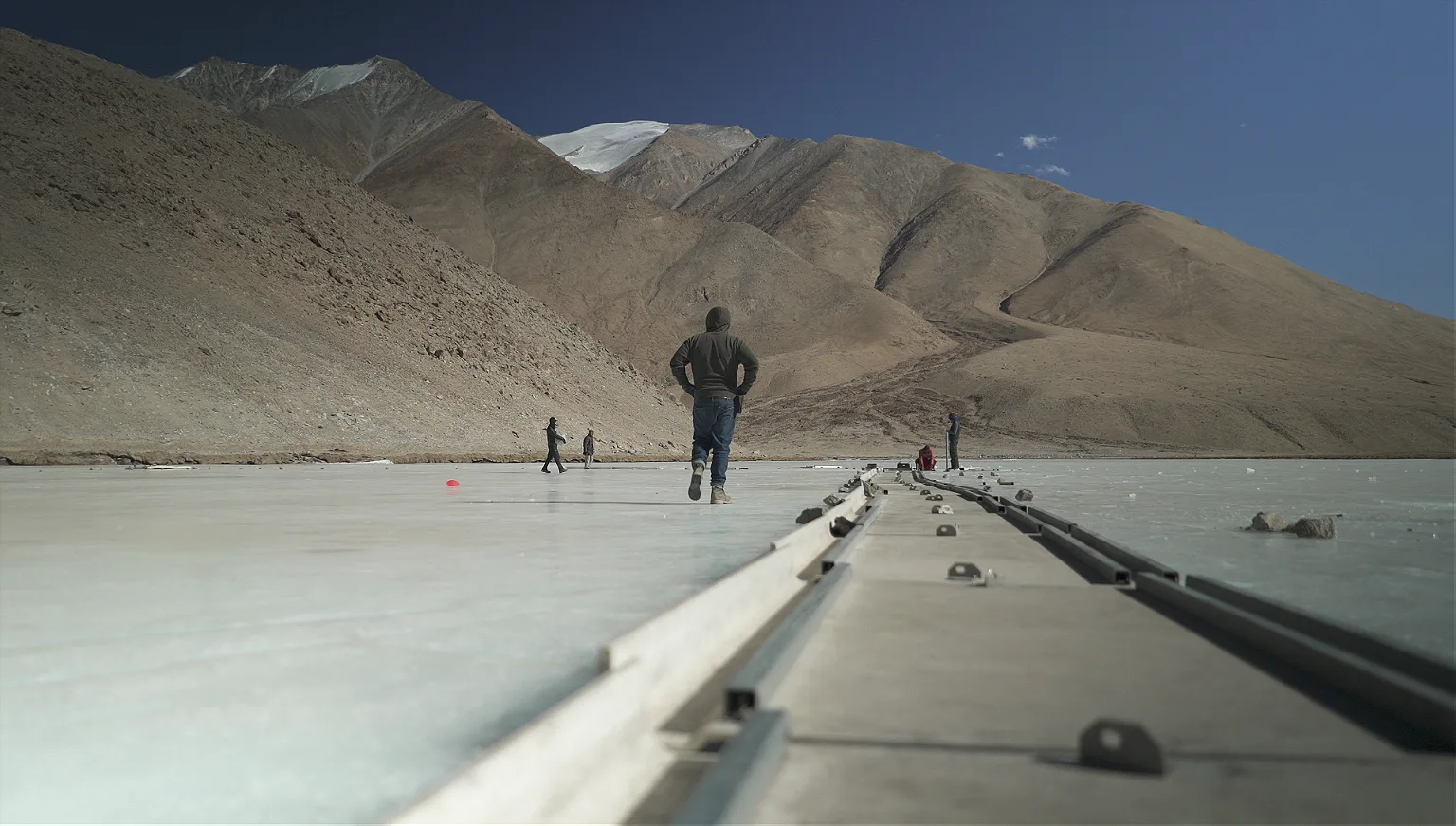
What the Silence Teaches
There is a kind of silence that can only exist at altitude—a silence so vast it has texture. In Chibra Kargyam, this quiet is not absence but presence. It surrounds every movement on the ice like a witness. To skate here is to confront not noise, but self.
In such silence, one realizes that the human need for play is deeply sacred. The body in motion affirms existence; the fall and recovery mirror the rhythm of life itself. This is what I have come to understand: that sport at the roof of the world is less about victory and more about reverence.
The ice listens, records, forgets. And in that forgetting, we find freedom.
“Perhaps the real game,” an old monk once told me in Nyoma, “is not played on the ice at all, but inside the mind that dares to move.”
Altitude Meets Attitude
At this height, even the ordinary becomes mythic. The way a puck slides, the laughter that shatters the cold, the sweat freezing on a sleeve—all are proof that endurance has its own kind of grace.
It is often said that altitude meets attitude here, but what it really means is that the mountain demands sincerity. You cannot fake strength when the air itself is a test. The rink becomes a stage of truth, and every stumble, every breath, every cheer is authentic.
Visitors who come expecting spectacle often leave with something quieter: an understanding that what endures is not performance, but presence.
6. How to Reach, When to Skate, What to Know
Reaching Chibra Kargyam
The route to Chibra Kargyam begins in Leh, following the Leh–Nyoma–Kargyam road through Tangtse and Mahe Bridge. The journey takes about eight hours by jeep, depending on snow and light. Travelers should plan acclimatization stops—high altitude sports demand patience. Fuel, warm clothing, and local guidance are essential, as mobile networks fade with every kilometer.
The best time to visit is between December and early February, when the cold is consistent and the rink holds steady. By late winter, sunlight can turn the ice deceptive.
Staying, Playing, and Preparing
Accommodation in Chibra Kargyam is simple but welcoming. Homestays provide butter tea, wool blankets, and stories that belong to this altitude. Visitors hoping to play should bring their own gear—skates, helmets, gloves—and check blades for sharpness; local shops cannot replace them easily.
Because the rink sits above 4,300 meters, acclimatization tips include slow pacing, hydration, and avoiding alcohol. Sunscreen and lip balm are more essential than one might expect. Nights drop well below –20°C, and mornings can dazzle with mirrored light. Bring respect as much as enthusiasm; the ice is a teacher, not a stage.
7. When the Ice Speaks — Reflections and Futures
Lessons from the Frozen Ground
The rink at Chibra Kargyam is more than a geographical curiosity—it is a living metaphor. It tells us that play can exist even in extremity, that community can bloom where oxygen thins.
In every match, there is a silent exchange between earth and motion: the mountain gives its stillness; the skater returns it in rhythm. This reciprocity is what sustains the sport here. And perhaps, in the end, this is the truest lesson—that endurance is a form of devotion.
The Future of Ice in Ladakh
There are plans to build more structured rinks in Leh, with refrigeration systems and tourist appeal. Yet, many locals fear that too much infrastructure will erase what makes the sport sacred.
For now, Chibra Kargyam remains a place of honesty—raw, wind-cut, and luminous. As winters grow uncertain, the village’s rink stands as both defiance and prayer. When the ice finally melts each year, it leaves behind invisible lines, like veins of memory across the land.
FAQ — Skating at the Roof of the World
What makes Chibra Kargyam special for ice hockey?
It is recognized as one of the world’s highest natural ice hockey grounds, surrounded by the Himalayas and built entirely by local hands using natural ice formed by the freezing of mountain water.
When is the best time to visit for skating?
The best season is mid-December to early February when temperatures remain below freezing, ensuring the rink’s stability and safety for both players and visitors.
Can beginners skate there?
Yes, but altitude adaptation is crucial. Beginners should spend at least two days in Leh before traveling to Chibra Kargyam to allow their bodies to adjust to the thin air and high elevation.
Is equipment available locally?
Only basic gear can be borrowed in nearby villages. Travelers are advised to carry their own skates, gloves, and helmets due to limited access to professional sports stores in the region.
How does climate change affect the rink?
Shorter winters and warmer days threaten the natural formation of ice. Locals often pour water at night to preserve the rink, but each year the window for skating becomes shorter.
Conclusion — The Poetics of Endurance
High in the Himalayas, where air becomes thought and ice becomes memory, Chibra Kargyam holds a truth that belongs to all who wander: that joy can be carved even from cold, that connection can shimmer between exhaustion and light.
Standing there at dusk, I watched the last game fade into wind and shadow. The rink, glowing faintly under the first stars, looked less like a sporting field and more like a mirror of everything fleeting.
To skate here is to write, briefly, on the surface of time. And when the ice melts, it carries those stories away—only to return again with the next breath of winter.
About the Author
Elena Marlowe
Elena Marlowe is an Irish-born writer currently residing in a quiet village near Lake Bled, Slovenia. She crafts elegant, reflective travel columns that explore the thresholds between landscape and inner life, with a particular focus on high-altitude cultures, desert plateaus, and the poetics of movement. Her work blends lyrical storytelling with practical insight, inviting readers to travel more slowly, notice more deeply, and connect with place through texture, scent, and silence.
Elena’s essays often trace the human pulse inside remote geographies—from wind-swept Himalayan valleys to winter-bound European lakes—bringing together local voices, history, and the intimate rituals of everyday life. When she is not writing, she can be found walking forest paths at dawn, gathering field notes for future journeys, or sharpening longhand drafts at a lakeside café.
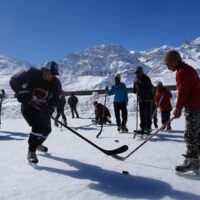
Ladakh Ice Hockey Cultural Exchange Program – Teach, Inspire, and Explore!
Join the Ice Hockey Cultural Exchange Program in the village of Chiktan, Ladakh! Teach ice hockey to passionate local children while immersing yourself in Ladakhi culture and experiencing a high-altitude sporting adventure.

